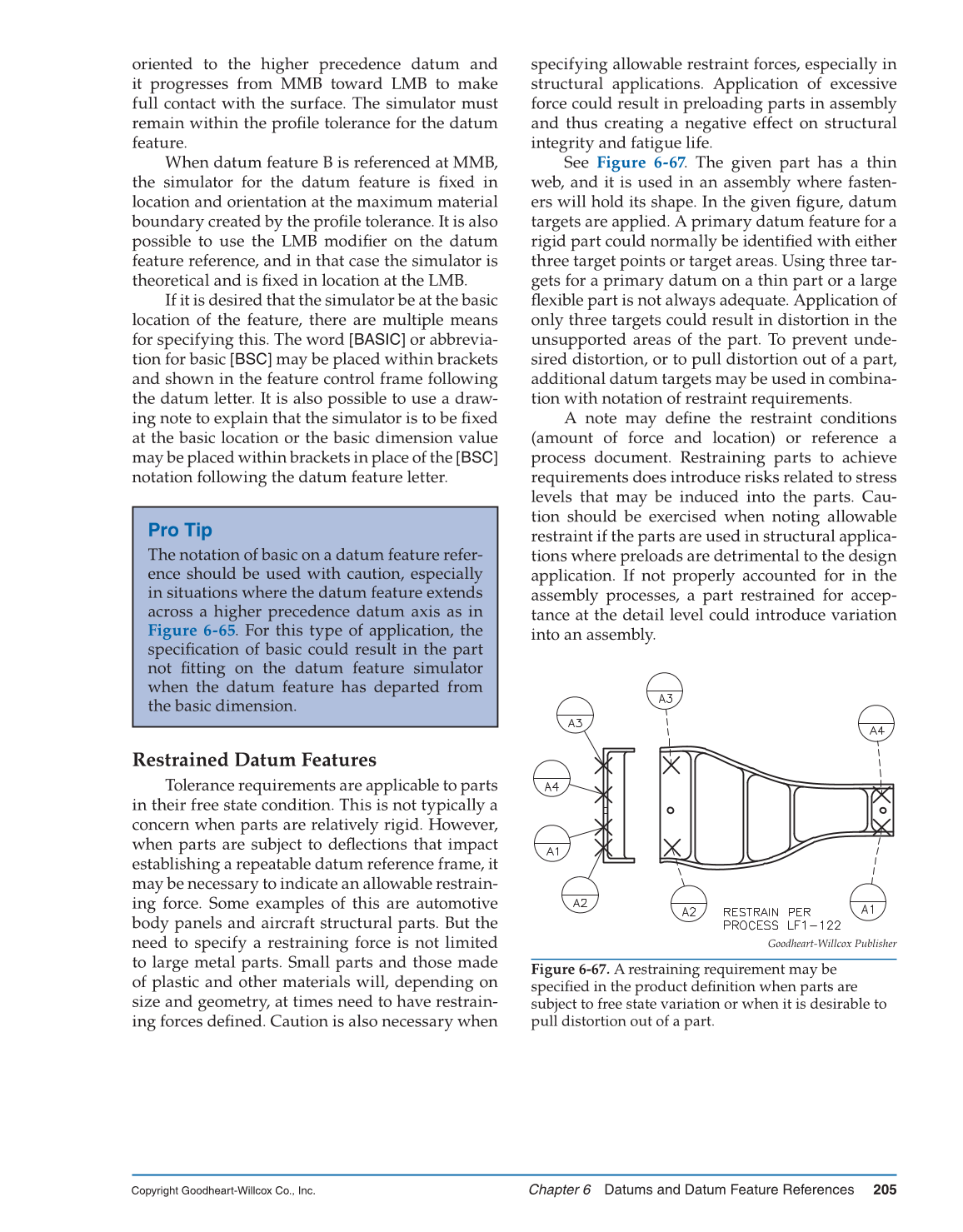Chapter 6 Datums and Datum Feature References 205
Copyright Goodheart-Willcox Co., Inc.
oriented to the higher precedence datum and
it progresses from MMB toward LMB to make
full contact with the surface. The simulator must
remain within the profi le tolerance for the datum
feature.
When datum feature B is referenced at MMB,
the simulator for the datum feature is fi xed in
location and orientation at the maximum material
boundary created by the profi le tolerance. It is also
possible to use the LMB modifi er on the datum
feature reference, and in that case the simulator is
theoretical and is fi xed in location at the LMB.
If it is desired that the simulator be at the basic
location of the feature, there are multiple means
for specifying this. The word [BASIC] or abbrevia-
tion for basic [BSC] may be placed within brackets
and shown in the feature control frame following
the datum letter. It is also possible to use a draw-
ing note to explain that the simulator is to be fi xed
at the basic location or the basic dimension value
may be placed within brackets in place of the [BSC]
notation following the datum feature letter.
specifying allowable restraint forces, especially in
structural applications. Application of excessive
force could result in preloading parts in assembly
and thus creating a negative effect on structural
integrity and fatigue life.
See Figure 6-67. The given part has a thin
web, and it is used in an assembly where fasten-
ers will hold its shape. In the given fi gure, datum
targets are applied. A primary datum feature for a
rigid part could normally be identifi ed with either
three target points or target areas. Using three tar-
gets for a primary datum on a thin part or a large
fl exible part is not always adequate. Application of
only three targets could result in distortion in the
unsupported areas of the part. To prevent unde-
sired distortion, or to pull distortion out of a part,
additional datum targets may be used in combina-
tion with notation of restraint requirements.
A note may defi ne the restraint conditions
(amount of force and location) or reference a
process document. Restraining parts to achieve
requirements does introduce risks related to stress
levels that may be induced into the parts. Cau-
tion should be exercised when noting allowable
restraint if the parts are used in structural applica-
tions where preloads are detrimental to the design
application. If not properly accounted for in the
assembly processes, a part restrained for accep-
tance at the detail level could introduce variation
into an assembly.
Pro Tip
The notation of basic on a datum feature refer-
ence should be used with caution, especially
in situations where the datum feature extends
across a higher precedence datum axis as in
Figure 6-65. For this type of application, the
specifi cation of basic could result in the part
not fi tting on the datum feature simulator
when the datum feature has departed from
the basic dimension.
Restrained Datum Features
Tolerance requirements are applicable to parts
in their free state condition. This is not typically a
concern when parts are relatively rigid. However,
when parts are subject to defl ections that impact
establishing a repeatable datum reference frame, it
may be necessary to indicate an allowable restrain-
ing force. Some examples of this are automotive
body panels and aircraft structural parts. But the
need to specify a restraining force is not limited
to large metal parts. Small parts and those made
of plastic and other materials will, depending on
size and geometry, at times need to have restrain-
ing forces defi ned. Caution is also necessary when
Goodheart-Willcox Publisher
Figure 6-67. A restraining requirement may be
specifi ed in the product defi nition when parts are
subject to free state variation or when it is desirable to
pull distortion out of a part.
